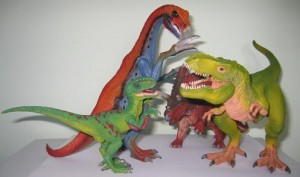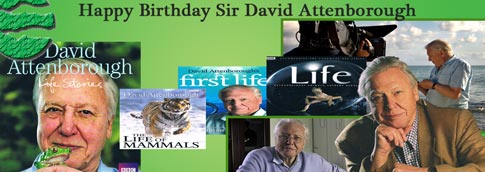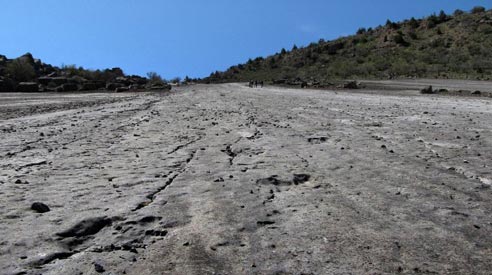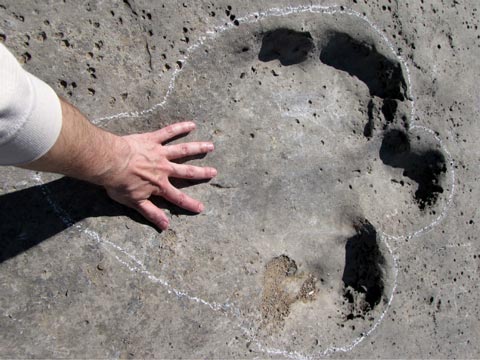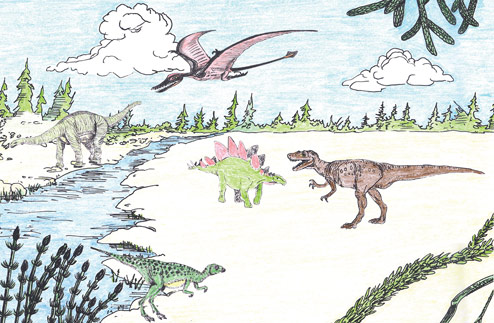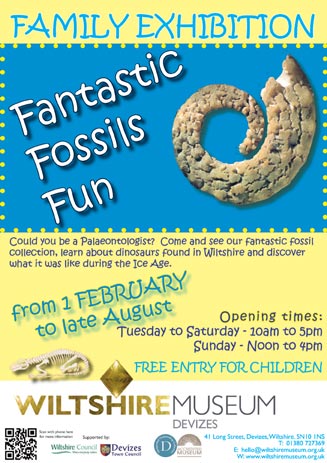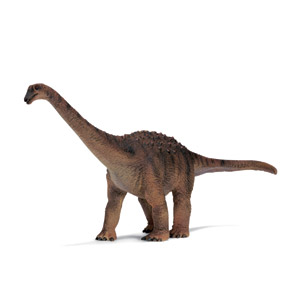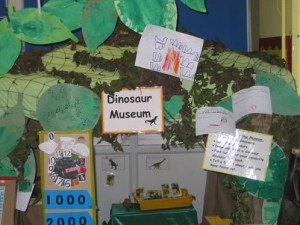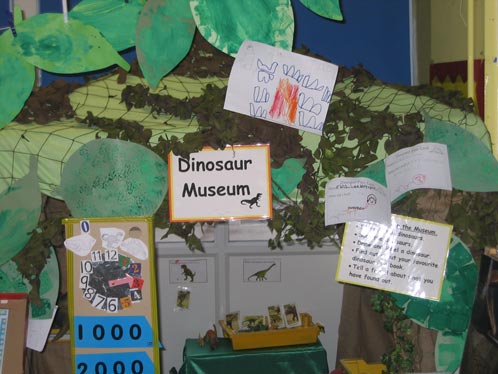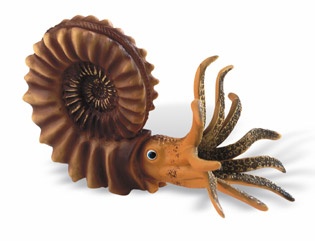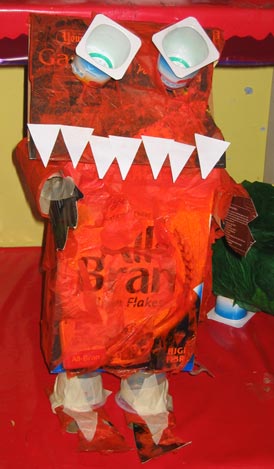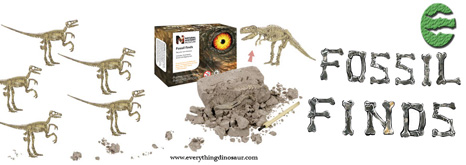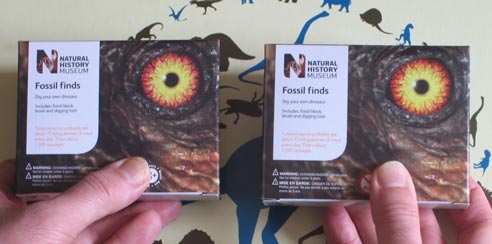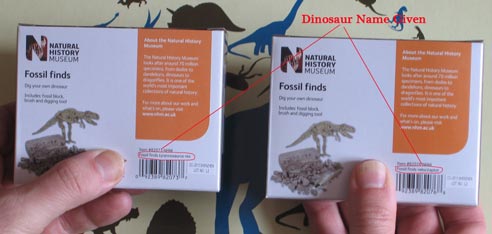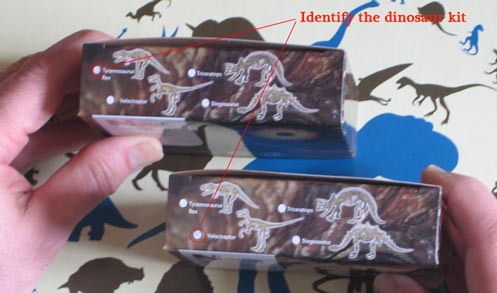New Study Suggests that Birds Survived Mass Extinction Events Because they Stayed Small
There has been a lot of media coverage today with regards to a paper published in the scientific journal PLOS Biology (Public Library of Science), that used an analysis of dinosaur and bird body masses to examine how quickly members of the Dinosauria including the ancestors of modern birds evolved to exploit new ecological niches. A lot of emphasis has been placed on the size and scale of the non-avian dinosaurs, we shall come to this in due course, but the main thrust of the academic paper does not concern itself with just how big some of the dinosaurs got.
Measuring Body Mass
In this instance, measuring body mass is a means to an end, the research suggests that on that branch of the Dinosauria family tree that leads to the birds (Aves), there was a sustained and very lengthy period of evolution of species. Birds and their direct dinosaur ancestors seem to have evolved rapidly for at least 170 million years, quickly diversifying and becoming more speciose to exploit niches in ecosystems as and when they arose. Other types of dinosaur, those not directly related to extant birds, seemed to evolve at a slower rate, once an initial burst of adaptive radiation took place to exploit those gaps left in the world’s terrestrial ecosystems after the End Triassic extinction event.
An International Team
The international team of researchers including academics from Oxford University, the Royal Ontario Museum of Canada, the University of Toronto, the Smithsonian Institute, Imperial College, University College of London, the IVPP (Beijing) and Sweden’s Uppsala University also suggest that the evolutionary ability of those birds that existed during the time of Cretaceous mass extinction event, to remain small may have assisted their survival. The larger, less diverse dinosaurs, the likes of Tyrannosaurus rex and Triceratops horridus died out.
Decreasing Body Size to Continuously Exploit New Ecological Niches
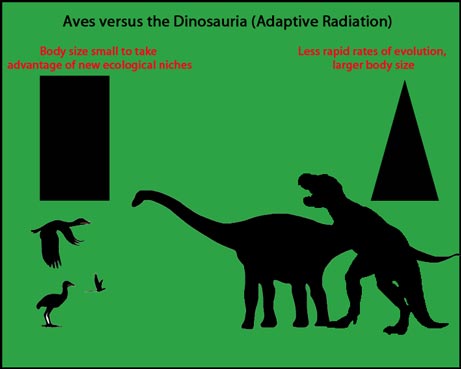
Small body size helped birds evolve rapidly.
Picture credit: Everything Dinosaur
Decreasing Body Size
The research team believes that the group that eventually evolved into birds decreased their body volume to continuously take advantage of new ecological niches through their evolution, becoming the successful species they are today. Small, may indeed have been beautiful when it came to surviving major extinction events and the more speciose your clade was, the more niches you as a clade occupied the better your chances of survival.
Let’s start at the beginning, the first dinosaurs evolved sometime in the Middle Triassic, palaeontologists can’t be certain as to when or even where, although some of the latest research suggests that the very first dinosaurs as we now know them evolved in Africa.
To read an article on what might have been one of the first dinosaurs: The First Dinosaur?
The first birds may have evolved in the region of 170 million years ago (Middle Jurassic), the problem with both the early dinosaurs and those early birds is that the fossil record is extremely poor and material fragmentary. It is difficult to establish a clear, evolutionary lineage.
To read an article about one of the first types of bird to evolve: New Contender for the “First Bird” – Aurornis.
What the fossil record does show is that in all the major groups of animals there was a rapid burst of evolution with lots of new body shapes and sizes rapidly evolving during their early history. Different types evolve to exploit niches in food chains. There is a rapid explosion of adaptive radiation amongst organisms. Adaptive radiation, to an evolutionary biologist is a process in which living things rapidly diversify into a vast array of new forms.
Mass Extinction Event
This burst of natural selection is often prompted by a mass extinction event that eliminates competitors or through climate change that opens up new territories and habitats to exploit. For example, the dinosaurs rapidly diversified into a number of different Superfamilies in the Early Jurassic, perhaps a biological response to the gaps left after the End Triassic extinction event.
Problem is, very few studies of adaptive radiation have looked at how Orders evolve over deep geological time, so the links between how diverse a modern day Order might be in relation to major extinct groups remains relatively unclear. This is what the international team of scientists set out to examine. Today, there are over 10,000 species of birds, they are the most speciose of all the living tetrapod clades, how did the evolution of the birds and their dinosaur ancestors compare to the evolutionary rates of other types of dinosaur not that closely related to the Aves?
Measuring the Pace of Development
To measure the pace of evolutionary development, the scientists chose to look at the variations in body mass. Put simply the idea is this:
- Look at the family tree of the dinosaurs and examine each of the major branches.
- Look at the body sizes of the different types of prehistoric animal (estimating body mass was undertaken by measuring the robustness and size of limb bones notably femurs)
Work on the basis that if closely related animals are similar in body size then evolutionary rates were probably slow.
However, if closely related animals show a very wide range in body size then evolutionary rates were probably very rapid
A comprehensive data set of body mass was compiled for the major types of dinosaur and birds that evolved in the Mesozoic. Although it is difficult to accurately estimate the weight of long extinct animals (a source of continual debate amongst scientists), in living creatures the scaling model based on the size and shaft circumference of major limb bones such as the thigh bone seems the most reliable.
From this study, the scientists concluded that the heaviest dinosaur known was Argentinosaurus (Argentinosaurus huinculensis) with an estimated body mass of around 90,000 kilogrammes.
Dinosaur Super-Heavyweight Argentinosaurus
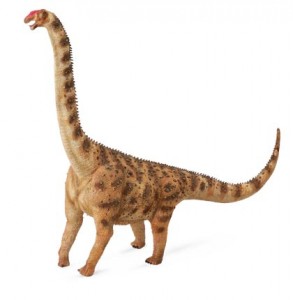
Biggest dinosaur known to science.
Estimating Body Weights of Dinosaurs
The body weights of 426 dinosaurs were estimated and when added to the number of bird species studied the total exceeds 600, the smallest and lightest species analysed was Qiliania (Q. graffini), a primitive bird whose fossils date from around 120 million years ago and come from China. Qiliania graffini weighed six million times less than Argentinosaurus huinculensis. However, Qiliania may have been tiny, but there are very few Mesozoic creatures that can claim to have been named after the founder of a punk rock band (Dr Gregory Graffin).
Estimated Body Masses of Various Types of Dinosauria (the Smallest Examples)
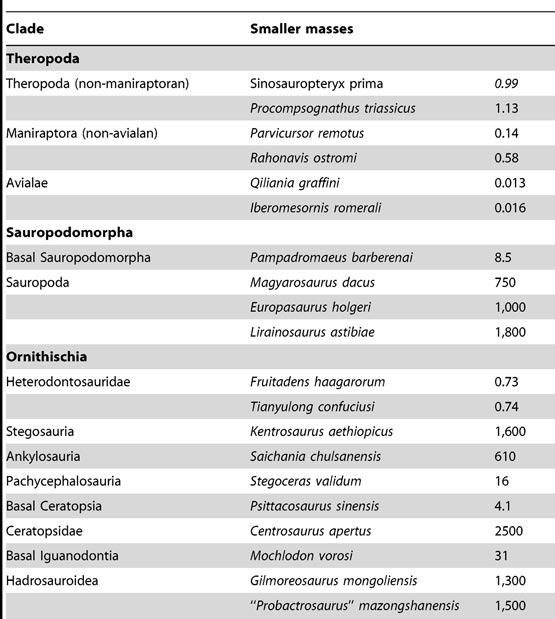
The estimated size of the smallest member of various dinosaur Superfamilies.
Table credit: PLOS One Biology
The table above lists the smallest Dinosauria members known by type of dinosaur, weights are given in kilogrammes.
Estimated Body Masses of Various Types of Dinosauria (the Biggest Examples)
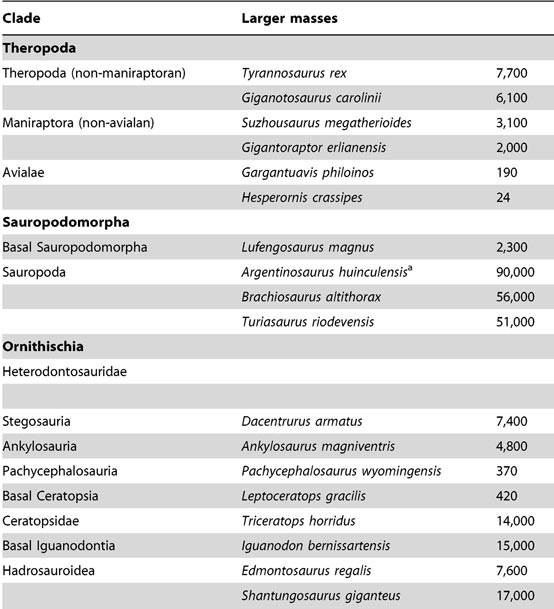
Estimated size of the biggest members of the Dinosauria.
Table credit: PLOS One Biology
The table above shows the body mass estimates of some of the biggest dinosaurs and birds known (weight in kilogrammes).
The Heaviest Types of Dinosaurs
The international team of researchers did not set out to re-classify the heaviest types of dinosaur and submit new information to the Guinness Book of Records, this is what has intrigued a number of media outlets and journalists who have focused on the estimated size and scale of these long extinct creatures. There are one or two notable points worth making. For instance, using the limb robustness and shaft circumference method, Tyrannosaurus rex comes out significantly heavier than Giganotosaurus carolinii. The herbivorous Iguanodon (I. bernissartenis) and Triceratops (T. horridus) are approximately twice as heavy as the fearsome T. rex.
But enough of this, let’s focus on the main aspect of this new research. The Dinosauria evolved very rapidly early on in their evolutionary history, but the speed of evolutionary change for most of the Superfamilies slowed down, if the relative body masses of closely related dinosaur types is used as a measure of evolutionary change.
Only in the Maniraptora, that clade of coelurosaurian theropods that gave rise to modern birds did that initial high rate of evolutionary change continue. According to Dr David Evans, the Curator of Vertebrate Palaeontology at the Royal Ontario Museum and one of the co-authors of the paper, the branch of the dinosaur family tree that led to the birds represents “the second major adaptive radius ring of dinosaurs”.
Examining Body Sizes
Closely related groups of dinosaurs with similar body sizes may not have evolved to exploit new opportunities with quite the same rapidity as the birds. As a result, when there was intense pressure put on the Superfamily because of environmental changes such as those that occurred at the end of the Cretaceous, extinction was the outcome.
Dinosaur Phylogeny Showing Nodes which indicate Exceptional Evolution of Body Size
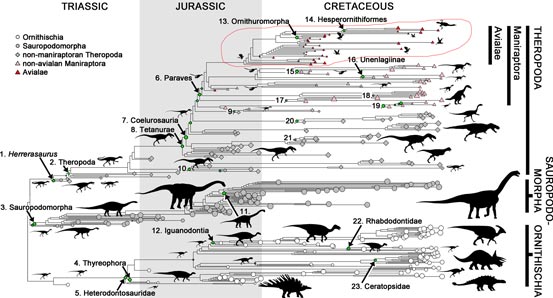
The Aves (Avialae) have been ringed faintly in red.
Picture credit: PLOS One Biology
Feathered maniraptoran dinosaurs, including those now classified as Mesozoic birds sustained a rate for rapid evolution, suggesting these taxa would have been much quicker at adapting to new ecological niches. Birds retained their ability to evolve very rapidly, a precondition of which was their relatively small size when compared to other dinosaurs.
The research team conclude that the smaller body masses attained by the Aves was the key to their survival, the birds lowered the body mass threshold of the Dinosauria below one kilogramme, subsequently individuals would need fewer resources to survive. It is thanks to these factors that the birds remain the most speciose of all the tetrapod vertebrates alive today.
Finally, for all those who wanted to see just how big Argentinosaurus was, we have reproduced below a drawing of a huge titanosaur. This dinosaur is only known from fragmentary remains and the casts have been made based on scaling up the sizes of bones from better known, more complete titanosaurs.
Just How Big was Argentinosaurus?
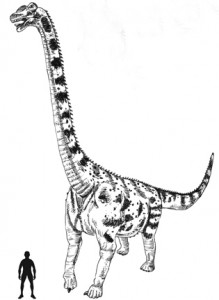
Huge dinosaurs – titanosaurids.
For dinosaur models and prehistoric animal figures: Dinosaur Models and Prehistoric Animal Models.



